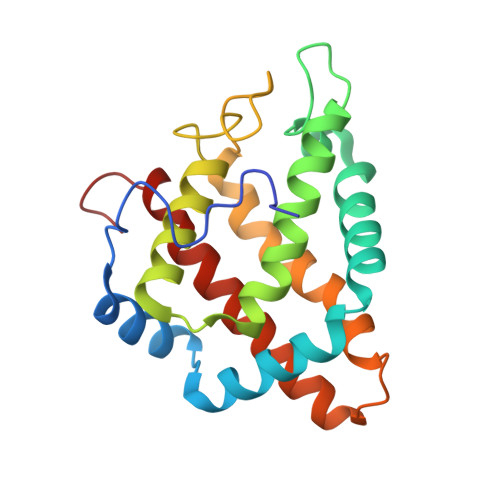Structure and Haem-Distal Site Plasticity in Methanosarcina Acetivorans Protoglobin.
Pesce, A., Tilleman, L., Donne, J., Aste, E., Ascenzi, P., Ciaccio, C., Coletta, M., Moens, L., Viappiani, C., Dewilde, S., Bolognesi, M., Nardini, M.(2013) PLoS One 8: 66144
- PubMed: 23776624
- DOI: https://doi.org/10.1371/journal.pone.0066144
- Primary Citation of Related Structures:
3ZJH, 3ZJI, 3ZJJ, 3ZJL, 3ZJM, 3ZJN, 3ZJO, 3ZJP, 3ZJQ, 3ZJR, 3ZJS - PubMed Abstract:
Protoglobin from Methanosarcina acetivorans C2A (MaPgb), a strictly anaerobic methanogenic Archaea, is a dimeric haem-protein whose biological role is still unknown. As other globins, protoglobin can bind O2, CO and NO reversibly in vitro, but it displays specific functional and structural properties within members of the hemoglobin superfamily. CO binding to and dissociation from the haem occurs through biphasic kinetics, which arise from binding to (and dissociation from) two distinct tertiary states in a ligation-dependent equilibrium. From the structural viewpoint, protoglobin-specific loops and a N-terminal extension of 20 residues completely bury the haem within the protein matrix. Thus, access of small ligand molecules to the haem is granted by two apolar tunnels, not common to other globins, which reach the haem distal site from locations at the B/G and B/E helix interfaces. Here, the roles played by residues Trp(60)B9, Tyr(61)B10 and Phe(93)E11 in ligand recognition and stabilization are analyzed, through crystallographic investigations on the ferric protein and on selected mutants. Specifically, protein structures are reported for protoglobin complexes with cyanide, with azide (also in the presence of Xenon), and with more bulky ligands, such as imidazole and nicotinamide. Values of the rate constant for cyanide dissociation from ferric MaPgb-cyanide complexes have been correlated to hydrogen bonds provided by Trp(60)B9 and Tyr(61)B10 that stabilize the haem-Fe(III)-bound cyanide. We show that protoglobin can strikingly reshape, in a ligand-dependent way, the haem distal site, where Phe(93)E11 acts as ligand sensor and controls accessibility to the haem through the tunnel system by modifying the conformation of Trp(60)B9.
Organizational Affiliation:
Department of Physics, University of Genova, Genova, Italy.

















